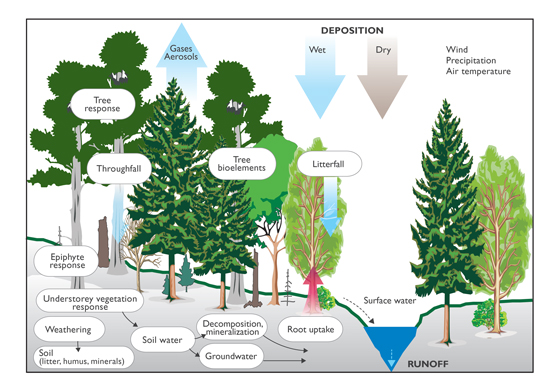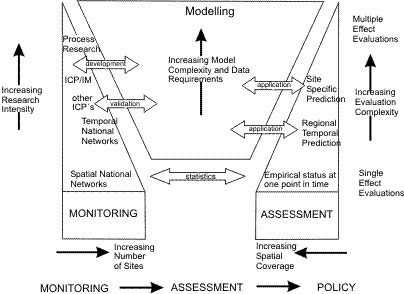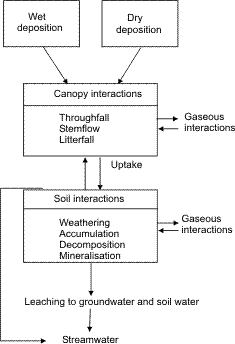1.1 Aims of the programme
The overall aim of integrated monitoring was originally to determine and predict the state and change of terrestrial and freshwater ecosystems in a long-term perspective with respect to the impact of air pollutants, especially nitrogen and sulphur. This was to provide one basis for decisions on emission controls and assessment of the ecological impact of such controls within the UNECE Convention on Long-Range Transboundary Air Pollution. However, the full implementation of the Integrated Monitoring Programme will allow the ecological effects of tropospheric ozone, heavy metals and persistent organic substances to be determined. Implementation of the Programme will provide a major contribution to the international data requirements for examining the ecosystem impacts of climatic change, changes in biodiversity and depletion of stratospheric ozone. A primary concern is the provision of scientific and statistically reliable data that can be used in modelling and decision making. The main emphasis is to establish consistent time series for environmental variables rather than establishing representative surveys across the UNECE region.
The aims are fulfilled by:
- monitoring both biogeochemical trends and biological responses in small (10 - 1000 ha) hydrologically defined areas
- seeking to separate the noise of natural variation, including succession, from the signal of anthropogenic disturbance by monitoring natural or semi-natural ecosystems
- developing and applying tools, e.g. models, for regional assessment and prediction of long-term effects.
Implementation of the IM Programme by individual countries will fulfill many of the obligations of those countries to undertake impacts studies not only under the Convention on Long-Range Transboundary Air Pollution, but also under the Framework Convention on Climate Change and the Convention on Biological Diversity.
1.2 The ecosystem monitoring concept
Integrated monitoring of ecosystems means physical, chemical and biological measurements over time of different ecosystem compartments simultaneously at the same location. In practice, monitoring is divided into a number of compartmental subprogrammes which are linked by use of the same parameters (cross-media flux approach) and/or the same/close stations (cause-effect approach). The quantification of these fluxes and pools, and monitoring the speed of changes in them, are essential for the development of any effects based environmental policies (e.g. Johnson and Lindberg 1992, Moldan and Cerny 1994).
A small catchment (or other hydrologically well defined area), such as an IM site, is large enough to encompass all the interacting components: atmosphere and vegetation, plants and soils, bedrock and groundwater, brook or lake, and surrounding land. A small catchment comprises a terrestrial ecosystem usually with a linked aquatic ecosystem of an adjacent brook. Some basins contain one or more ponds or lakes. A terrestrial ecosystem is conventionally viewed as an assemblage of living organisms interacting in a complex way with one another and with their environment, air, soil and water (Moldan and Cerny 1994). A conceptual scheme of a small catchment ecosystem is given in Figure 1.1.

Figure 1.1 A conceptual scheme of a small catchment ecosystem showing main components (pools) and processes (fluxes) which are the objects of integrated monitoring
Regional development of policy to regulate emission of anthropogenic pollutants (e.g. through development of critical loads) requires evaluation and assessment of environmental monitoring data (Figure 1.2). Assessment leading to policy definition is linked back to monitoring through the development and application of ecosystem models. The ICP IM falls within the monitoring component of this overall framework, and the following discussion will focus on its specific position and role.
|
|
|

|
|
Figure 1.2 Conceptual model of the means by which rational environmental policy is developed through a sequence of monitoring and assessment. The ICP IM programme's position in the hierarchy of monitoring programmes is indicated.
|
A national or international monitoring programme to evaluate the environmental effects of any anthropogenic perturbation (e.g. acidic deposition, toxic contaminants, climate change etc.) is best organised in an integrated, hierarchical manner (represented by the left pyramid in Figure 1.2). At the apex of the pyramid is a small number of intensively monitored process research sites. Here sufficient information is collected so that time-dependent models may be developed to predict future changes in the state of the ecosystem. The changes may occur in response to increased or decreased pollutant inputs. Many ECE countries operate a small number (1-10) of such sites.
Beneath the apex regional monitoring networks are indicated which use progressively less frequent sampling at progressively more sites. The base of the monitoring pyramid is composed of national 'surveys' in which sampling may occur as infrequently as once or twice per decade. The number of hierarchical levels presented in Figure 1.2 is probably a minimum for effective ecosystem monitoring on an international scale.
Within the hierarchy, the ICP IM falls somewhat below the pyramid apex, and represents a source of information for comparison of complex and multiple effects across climatic gradients as well as geological, ecozone, and political boundaries. Much of the data reported to the international level are time averaged (e.g. monthly volume-weighted runoff concentrations). They are very useful for validating models and testing 'universality'. Once confidence in model performance has been obtained, application to lower hierarchical levels produces regional assessment, involving either temporal or scenario based production. Hence, multiple hierarchical levels of monitoring are necessary in order to supply the information needed for the model development - validation - application process. The IM presents the highest level having international co-operation and therefore, it is in an excellent position to respond to the needs of international policy makers. On its own, however, the ICP IM can not supply policy related information (e.g. critical loads); for political decisions we also depend on the simultaneous existence of lower hierarchies indicating the regional variation.
Two other features of the monitoring hierarchy should be noted. First, there should be some overlap between hierarchies to ensure data and model transferability among levels. Some ECE countries maintain one or more monitoring sites that contribute not only to process research but also to the ICP IM and other ICP programmes. This is wise. Such sites are the primary source of 'ground truth' for validating and/or modifying ecosystem assessment models. Furthermore, it helps to maximise the scientific return obtained from the large resource expenditure required to operate such sites. Second, there is an inherent assumption of the continuing existence of all levels of the hierarchy. Piecemeal, intermittent, and short-term monitoring does not provide the information on temporal or spatial variations required to distinguish natural from anthropogenically induced effects. Arbitrary discontinuation of any given monitoring hierarchy may lead to collapse of the framework and an inability to effectively perform environmental assessment on either the national or international scales.
1.3 Mass balance performances
One of the central IM approaches is to monitor the mass balance of major chemical components within the site. Fundamental to this is the hydrological balance, which can be described as:
P - E = R ±ΔS
where, P = Precipitation, E = Evapotranspiration, R = Runoff and ΔS = Change in storage
The approach consists of an open-system analysis of external fluxes (Figure 1.3). The aim is to quantify fluxes and to monitor their rate over time. Simple mass balances can further be broken down into more complex ones for studying dose-response relationships (Figure 1.3).
|
|
|

|
|
Figure 1.3. Flows of substances within a forest ecosystem. Models of different complexity can be used for describing the ecosystem mass balance.
|
1.4 Model applications
Prediction of the future response of ecosystems to changes in pollutant loading and environmental conditions is necessary from both a scientific and political viewpoint. These predictions provide the only basis for the formulation and quantification of remedial measures. In this respect, mathematical simulation models which are capable of predicting system response under future pollution deposition scenarios represent our best tools. These models must be capable of describing the physical, chemical and biological relationships observed in ecosystems. The degree of damage to an ecosystem can then be estimated provided the models are based upon dose - response principles. Since the output from a model is only as good as the input data used to drive it, a comprehensive monitoring programme to identify the system function and provide adequate data for model calibration is essential.
Three well-known dynamic biogeochemical models (MAGIC, SAFE, SMART) have already been applied to selected IM sites (see: ICP IM Annual Report 1996, Forsius et al, 1998 a and b, Jenkins et al 2003). The advantage of applying the same model to many sites is that a consistent approach can be utilised and sensible comparisons can be made. Once established, a model covering many sites can be used to evaluate emission control strategies, and long term changes in policy, and used to investigate trends in the data. This is one of the most powerful ways of using ICP IM data for supporting work under the LRTAP Convention, and this topic should be given high priority also in the future. This requires a continuous effort to improve the data collection and reporting procedures in the IM Programme.
The widespread coverage of sites in the ICP IM is ideally designed for the application of models rather than model development. This is supported by the benefits of the central database allowing commonality of approach to data manipulation and aggregation for model calibration. Model development requires specific design of sampling and experimentation and the task is better left to more process oriented research programmes. The strength of the ICP IM modelling effort lies in scenario assessment through widespread site applications and the development of technologies for linking models for integrated assessment of environmental change utilising the integrated data sets available.
Currently available models generally focus on one aspect of an ecosystem, notably atmospheric deposition, soil/soil solution chemistry or biology. Biological models, on the other hand, require further development to achieve the mechanistic level of the hydrochemical and deposition models. Nevertheless, these models, when linked to predictions from hydrochemical models, provide useful prognoses of future behaviour of, e.g. long-term plant and vegetation response to changes in pollutant deposition.
There is some way to go in model development before ozone and heavy metals are incorporated as driving variables into ecosystem models, and even the role of nitrogen is not yet fully understood. These developments must take place outside the ICP IM. As new models are developed, however, they could be widely applied within the ICP IM framework, as could all suitable existing models. The ICP IM provides a unique database for validation and testing of such models, presuming complete data sets from the participating countries.
1.5 Bioindication
It is important to recognise biological indications of environmental stress because they are integrated responses to ecosystem change. Monitoring of biological variables makes it also possible to detect the cause-effect relationships within the ecosystem. One distinct advantage of the ICP IM is the possibility to integrate biological variables reliably to a wide selection of physico-chemical variables which are measured simultaneously. This is necessary if one tries to couple biological data in ecosystem modelling.
As the evaluation report (1992) of IMP states, forest growth and nutritional status are the most important variables from the modelling point of view. In addition to these, a collection of a number of self-indicating biological variables is also recommended. Thus in the programme, a number of biological data are included which are not directly used in the models but can be used as indicators of changes.
There are also biological indices that may suit to the framework of the ICP IM but which are not found in the variable list of the programme. The reason is that the suitability of a variable for long-term monitoring depends also on advancement of methodology, cost of equipment and materials, availability of trained personnel and potential sources of funding. Still underdeveloped methods are one of the main problems when applying biological parameters to a monitoring system and for this reason many good indices can not be used.
Many aspects of bioindication will require national development because of the specific conditions within individual countries.
1.6 References
Evaluation of Integrated Monitoring in Terrestrial Reference Areas of Europe and North America. The Pilot Programme 1989-1991. Environment Data Centre, National Board of Waters and the Environment, Helsinki 1992.
Forsius, M., Guardans, R., Jenkins, A., Lundin, L. and Nielsen, K.E. (eds.) 1998. Integrated Monitoring: Environmental assessment through model and empirical analysis - Final results from an EU/LIFE- project. The Finnish Environment 218. Finnish Environment Institute, Helsinki. ISBN 952-11-0302-7.
Forsius, M., Alveteg, M., Jenkins, A., Johansson, M., Kleemola, S., Lükewille, A., Posch, M., Sverdrup, H. , and Walse C. 1998. MAGIC, SAFE and SMART model applications at Integrated Monitoring sites: Effects of emission reduction scenarios. Water Air and Soil Pollution 105:21-30, 1998.
Jenkins, A., Larssen, T., Moldan, F., Hruška, J., Krám, P. and Kleemola, S. 2003. Dynamic modelling at Integrated Monitoring sites - Model testing against observations and uncertainty. The Finnish Environment 636. Finnish Environment Institute, Helsinki, Finland. ISBN 952-11-1440-1. 37 pp.
Johnson and Lindberg (eds), 1992. Atmospheric Deposition and Forest Nutrient Cycling. Ecological Studies 91. Springer-Verlag. New York 1992. ISBN 0-387-97632-9, ISBN 3-540-97632-9.
Kleemola S., Forsius M. (eds), 5th Annual Report 1996. UN ECE ICP Integrated Monitoring. The Finnish Environment 27. Finnish Environment Institute, Helsinki, Finland. ISBN 952-11-0045-1.
Moldan and Cerny (eds), 1994. Biogeochemistry of Small Catchments. A Tool for Environmental Research. Wiley. Chichester, England. ISBN 0-471-93723-1.